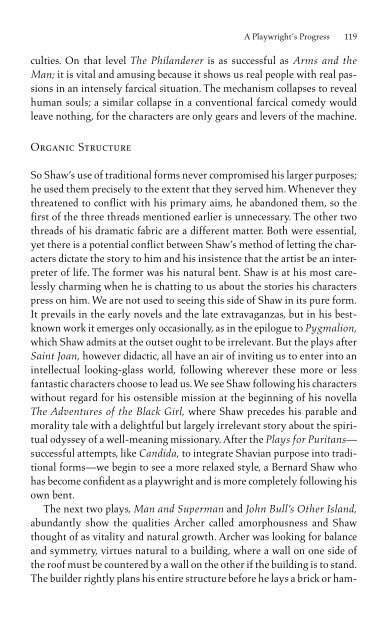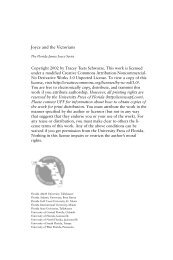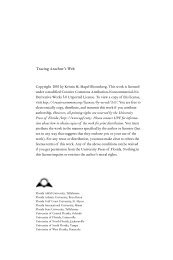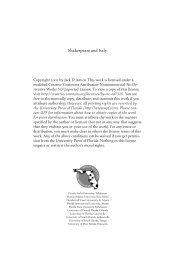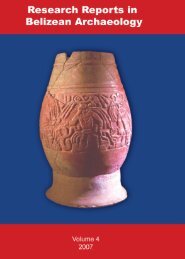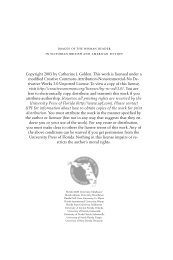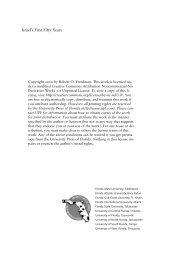Bernard Shaw's Remarkable Religion: A Faith That Fits the Facts
Bernard Shaw's Remarkable Religion: A Faith That Fits the Facts
Bernard Shaw's Remarkable Religion: A Faith That Fits the Facts
You also want an ePaper? Increase the reach of your titles
YUMPU automatically turns print PDFs into web optimized ePapers that Google loves.
A Playwright’s Progress 119<br />
culties. On that level The Philanderer is as successful as Arms and <strong>the</strong><br />
Man; it is vital and amusing because it shows us real people with real passions<br />
in an intensely farcical situation. The mechanism collapses to reveal<br />
human souls; a similar collapse in a conventional farcical comedy would<br />
leave nothing, for <strong>the</strong> characters are only gears and levers of <strong>the</strong> machine.<br />
Organic Structure<br />
So Shaw’s use of traditional forms never compromised his larger purposes;<br />
he used <strong>the</strong>m precisely to <strong>the</strong> extent that <strong>the</strong>y served him. Whenever <strong>the</strong>y<br />
threatened to conflict with his primary aims, he abandoned <strong>the</strong>m, so <strong>the</strong><br />
first of <strong>the</strong> three threads mentioned earlier is unnecessary. The o<strong>the</strong>r two<br />
threads of his dramatic fabric are a different matter. Both were essential,<br />
yet <strong>the</strong>re is a potential conflict between Shaw’s method of letting <strong>the</strong> characters<br />
dictate <strong>the</strong> story to him and his insistence that <strong>the</strong> artist be an interpreter<br />
of life. The former was his natural bent. Shaw is at his most carelessly<br />
charming when he is chatting to us about <strong>the</strong> stories his characters<br />
press on him. We are not used to seeing this side of Shaw in its pure form.<br />
It prevails in <strong>the</strong> early novels and <strong>the</strong> late extravaganzas, but in his bestknown<br />
work it emerges only occasionally, as in <strong>the</strong> epilogue to Pygmalion,<br />
which Shaw admits at <strong>the</strong> outset ought to be irrelevant. But <strong>the</strong> plays after<br />
Saint Joan, however didactic, all have an air of inviting us to enter into an<br />
intellectual looking-glass world, following wherever <strong>the</strong>se more or less<br />
fantastic characters choose to lead us. We see Shaw following his characters<br />
without regard for his ostensible mission at <strong>the</strong> beginning of his novella<br />
The Adventures of <strong>the</strong> Black Girl, where Shaw precedes his parable and<br />
morality tale with a delightful but largely irrelevant story about <strong>the</strong> spiritual<br />
odyssey of a well-meaning missionary. After <strong>the</strong> Plays for Puritans—<br />
successful attempts, like Candida, to integrate Shavian purpose into traditional<br />
forms—we begin to see a more relaxed style, a <strong>Bernard</strong> Shaw who<br />
has become confident as a playwright and is more completely following his<br />
own bent.<br />
The next two plays, Man and Superman and John Bull’s O<strong>the</strong>r Island,<br />
abundantly show <strong>the</strong> qualities Archer called amorphousness and Shaw<br />
thought of as vitality and natural growth. Archer was looking for balance<br />
and symmetry, virtues natural to a building, where a wall on one side of<br />
<strong>the</strong> roof must be countered by a wall on <strong>the</strong> o<strong>the</strong>r if <strong>the</strong> building is to stand.<br />
The builder rightly plans his entire structure before he lays a brick or ham-


